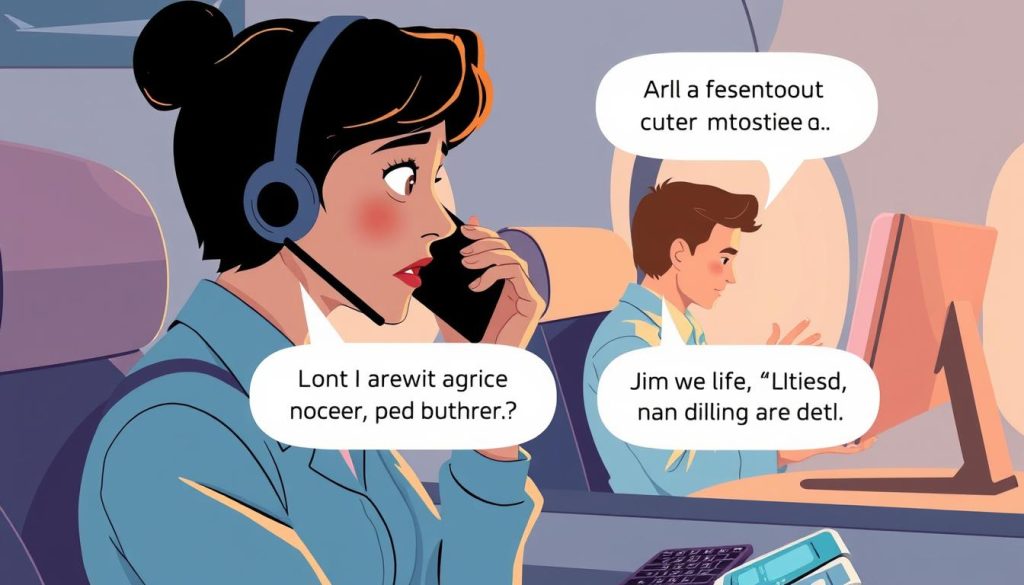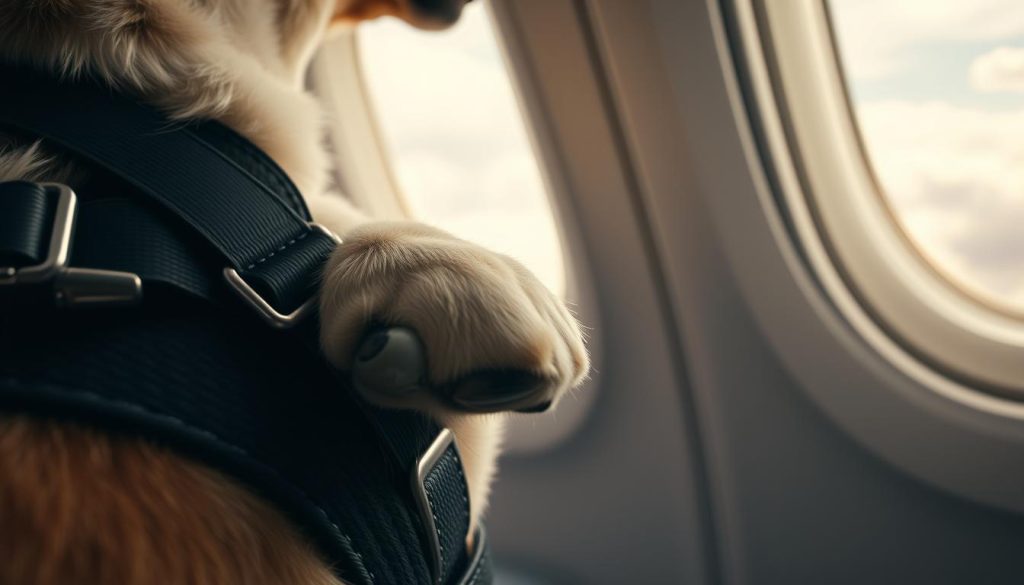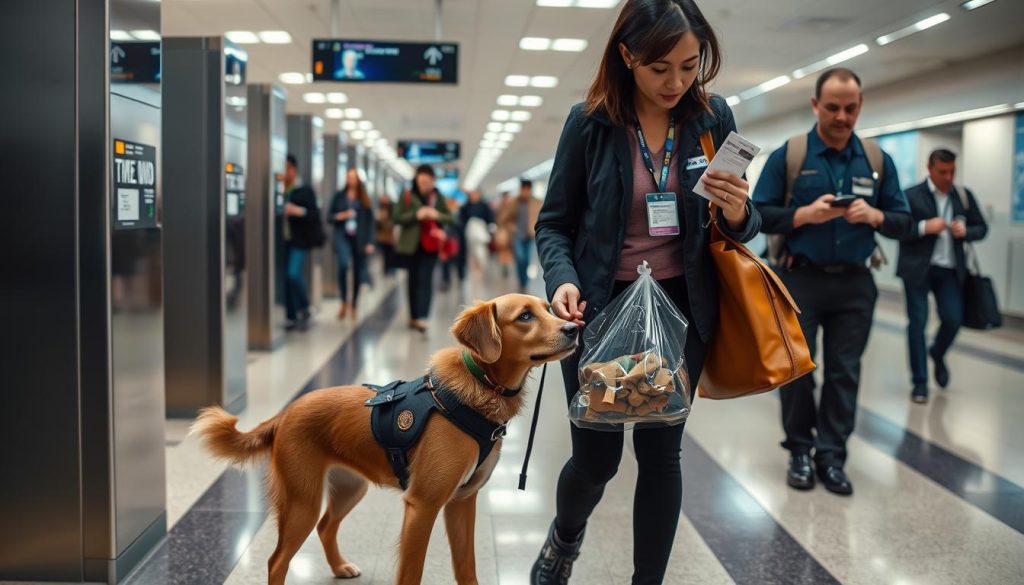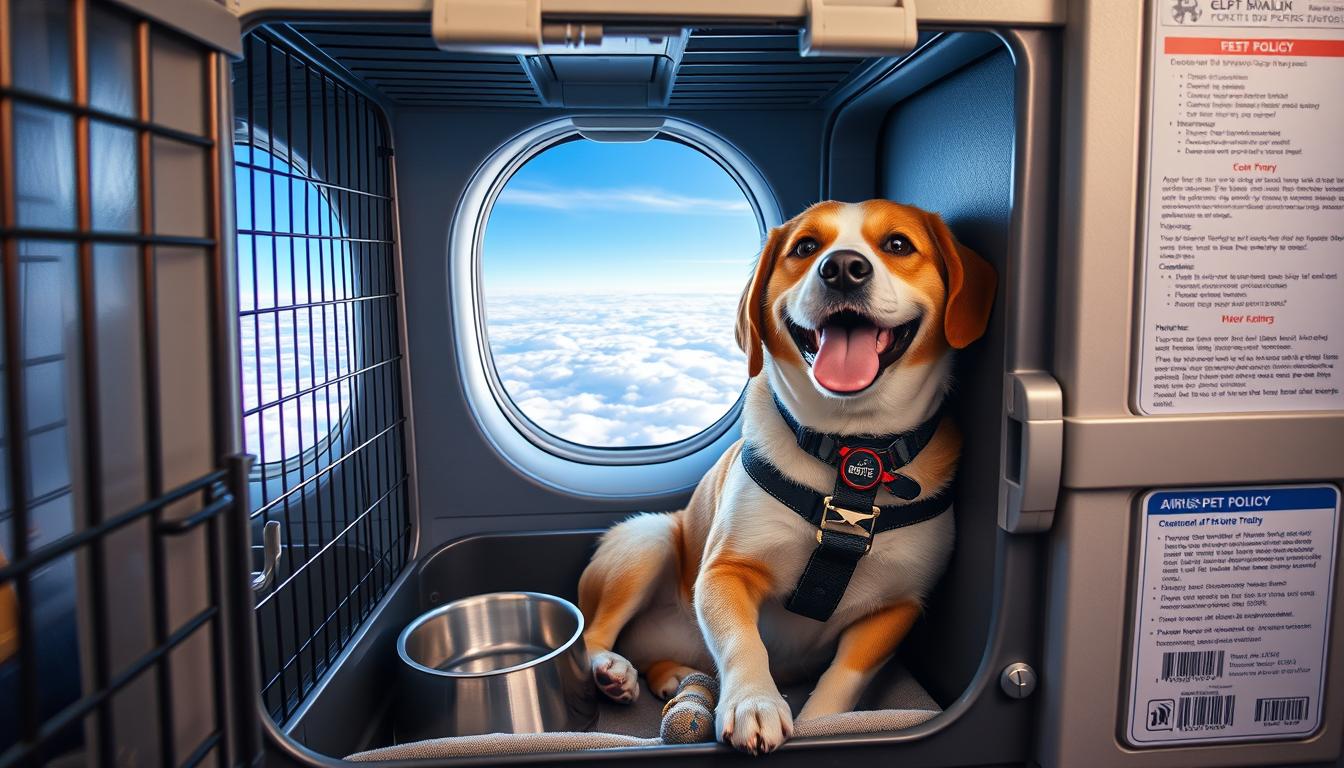Are you planning to take your dog on a flight? I’m here to help with my guide on dog air travel tips. These tips will make sure your dog is safe and comfy during the flight. You’ll learn how to call the airline, prepare your dog, and go through airport security.
Taking your dog on a trip can be fun but comes with its own set of challenges. With the right knowledge and planning, you can make the trip smooth for you and your dog.
Call the Airline and Ask Essential Questions

Before you book your flight, make sure to call the airline. Ask about their rules for bringing your dog along. This helps make sure your trip is smooth and worry-free for you and your pet.
Inquire About Pet Policies and Requirements
Talk to the airline about these key points:
- Weight limits for pets and their carriers
- Breed restrictions or bans
- Any extra fees for flying with a dog
- Size and dimensions needed for pet carriers
- Policies on emotional support or service animals
Obtain Necessary Documentation and Forms
You also need to get all the papers and forms for your dog to fly. These usually include:
- Up-to-date health certificates and vaccination records
- Completed pet travel forms, needed online and in print
- Proof of your dog’s ID, like a microchip or ID tag
Calling the airline and getting all the info and papers helps make your trip with your dog go smoothly.
Prepare Your Pup for the Journey

Making sure your furry friend is comfortable during air travel is key. Use calming aids or medication your vet suggests to keep your dog calm. These are great for anxious or high-strung dogs.
Consider Calming Aids or Medication
There are many calming aids for dogs, like pheromone diffusers, vests, and natural supplements. Talk to your vet to find the best one for your pet. Your vet might also suggest a mild sedative or anti-anxiety drug for the flight.
Pack Essential Supplies for the Flight
- Travel carrier: Make sure your dog’s carrier fits airline rules and lets them move easily.
- Water and food: Pack your dog’s usual food and water bowls, along with enough water and treats for the trip.
- Toys and bedding: Bring your dog’s favorite toys and a familiar blanket or bed for comfort.
- Potty pads: Have a few potty pads ready in case your dog needs to go during the flight.
- Cleaning supplies: Pack plastic bags, paper towels, and pet-safe cleaning wipes to keep the carrier clean.
With calming aids or medication and the right supplies, your pup will have a smooth and comfy flight.
Navigate Airport Security with Your Furry Friend

Going through airport security with your dog might seem tough, but it’s easier than you think. Knowing the TSA rules for dogs on planes helps. Also, following a few simple steps makes the process smoother for you and your pup.
Being prepared is key when flying with your dog. First, check that your dog’s carrier is okay for flying and can go through the X-ray machine. You’ll need to carry your dog as you go through the metal detector. Have your pet’s ID and any needed papers ready.
- Learn about TSA rules for dogs on planes, like size and weight limits for pets in the cabin.
- Make sure your dog’s carrier is okay for flying and fits through the X-ray machine.
- Keep your dog’s ID, health papers, and other needed documents handy.
- Be patient and work with TSA agents if they need to check on your pup.
These easy tips help you get through airport security with your dog. A bit of prep and a positive outlook makes flying with your dog easy and stress-free.
Understand the Risks of Cargo Hold Travel
Flying with your furry friend comes with risks you can’t ignore. The dangers of the airplane cargo hold for pets are real. It’s important to know these risks before booking your pet’s travel.
Most pets arrive safely in the cargo hold. But, the conditions there can be tough. Extreme temperatures, bad air, and rough handling by airport staff can harm your dog. If your pup must go in the cargo hold, take steps to lower these risks and keep them safe.
- Extreme temperatures: The cargo hold can get very hot or cold, which is bad for your pet.
- Poor ventilation: The cargo area might not have enough air, making it hard for your dog to breathe.
- Improper handling: Airport staff might not handle your pet carefully, causing injuries or stress.
Knowing the risks of putting your dog in cargo and the dangers of the airplane cargo hold for pets helps you make a smart choice. Be careful, take steps to protect your pet, and put their health first during the trip.
dog air travel tips: Cabin or Cargo – What’s Best?
Deciding whether to fly your dog in the cabin or cargo can be hard. The cabin seems safer and more comfy, but it has its downsides too. Think about the pros and cons for each option.
Keeping your dog in the cabin is usually best if you can. It lets you watch over your pet and comfort them during the flight. But, only small dogs can sit under the seat in front of you. Bigger dogs must go in the cargo hold.
The cargo hold can be risky for dogs because they’re away from you. But, airlines make sure pets in cargo are safe with the right temperature and air pressure. If your dog goes in cargo, pick a direct flight and the best time to travel to lessen stress.
Choosing between the cabin or cargo for your dog depends on their size, airline rules, and what you’re okay with. No matter your choice, make sure to look into the airline’s rules, get your dog ready for the flight, and look out for their well-being during the trip.
Cabin or Cargo: Weigh the Pros and Cons
- Cabin travel is generally safer and more comfortable for small dogs
- Cargo hold may be the only option for larger dogs, with some airline precautions in place
- Cabin space is limited, so check with the airline on size restrictions
- Cargo hold can be stressful, but direct flights and optimal timing can help
Choosing the right option for your dog is key to their safety and happiness when flying. With some planning and research, you can make sure your trip is smooth for both of you.
Precautions for Traveling with Pets in Cargo
If your pet must go in the cargo area, take extra steps for their safety and comfort. It’s important to pick the right flight times and prepare their carrier well. This makes the trip smoother for them.
Choose Direct Flights and Optimal Travel Times
Try to pick direct flights to avoid delays and errors during stops. Early morning or late evening flights are best for pets. This is because the midday heat can be harmful, especially when flying dogs in cargo.
Prepare Your Pet’s Carrier for Safe Transport
Getting your pet’s carrier ready is key for safe travel. Make sure to clip your dog’s nails to prevent them from getting stuck in the crate. Also, add up-to-date identification tags for safety. Let your pet get used to the carrier before the flight. This makes them feel safe and secure during the best flight times for pets in cargo.
By following these easy steps, you can make sure your pet has a safe and calm trip. Even when they travel in the cargo area, they’ll be okay.
Speak Up and Report Any Mishandling
If you see your pet or another animal being mistreated on a flight, speak up. Tell a manager or airline staff right away, both in person and in writing. Your voice can help make flying better for all pets.
Airlines are getting better at being pet-friendly. But, we can always do more. By telling them about any bad treatment, you help make things better for pets. We can make flying safe and comfy for all dogs and cats.
Your pet’s safety and happiness are the most important things. Don’t be shy to report even small issues. Your words can really help pets. Let’s make flying better for pets together.

